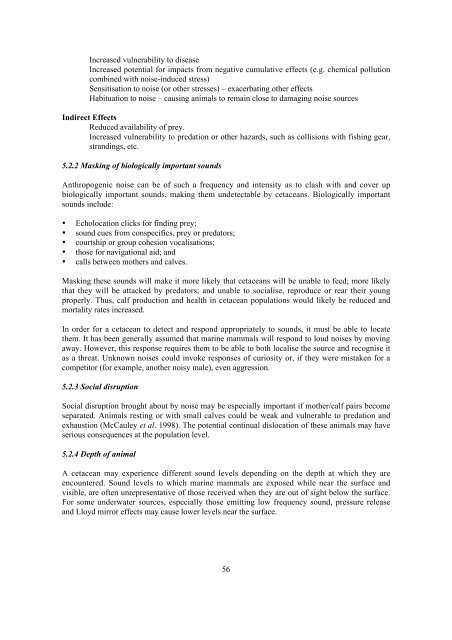Oceans of noise - Whale and Dolphin Conservation Society
Oceans of noise - Whale and Dolphin Conservation Society
Oceans of noise - Whale and Dolphin Conservation Society
You also want an ePaper? Increase the reach of your titles
YUMPU automatically turns print PDFs into web optimized ePapers that Google loves.
Increased vulnerability to disease<br />
Increased potential for impacts from negative cumulative effects (e.g. chemical pollution<br />
combined with <strong>noise</strong>-induced stress)<br />
Sensitisation to <strong>noise</strong> (or other stresses) – exacerbating other effects<br />
Habituation to <strong>noise</strong> – causing animals to remain close to damaging <strong>noise</strong> sources<br />
Indirect Effects<br />
Reduced availability <strong>of</strong> prey.<br />
Increased vulnerability to predation or other hazards, such as collisions with fishing gear,<br />
str<strong>and</strong>ings, etc.<br />
5.2.2 Masking <strong>of</strong> biologically important sounds<br />
Anthropogenic <strong>noise</strong> can be <strong>of</strong> such a frequency <strong>and</strong> intensity as to clash with <strong>and</strong> cover up<br />
biologically important sounds, making them undetectable by cetaceans. Biologically important<br />
sounds include:<br />
Echolocation clicks for finding prey;<br />
sound cues from conspecifics, prey or predators;<br />
courtship or group cohesion vocalisations;<br />
those for navigational aid; <strong>and</strong><br />
calls between mothers <strong>and</strong> calves.<br />
Masking these sounds will make it more likely that cetaceans will be unable to feed; more likely<br />
that they will be attacked by predators; <strong>and</strong> unable to socialise, reproduce or rear their young<br />
properly. Thus, calf production <strong>and</strong> health in cetacean populations would likely be reduced <strong>and</strong><br />
mortality rates increased.<br />
In order for a cetacean to detect <strong>and</strong> respond appropriately to sounds, it must be able to locate<br />
them. It has been generally assumed that marine mammals will respond to loud <strong>noise</strong>s by moving<br />
away. However, this response requires them to be able to both localise the source <strong>and</strong> recognise it<br />
as a threat. Unknown <strong>noise</strong>s could invoke responses <strong>of</strong> curiosity or, if they were mistaken for a<br />
competitor (for example, another noisy male), even aggression.<br />
5.2.3 Social disruption<br />
Social disruption brought about by <strong>noise</strong> may be especially important if mother/calf pairs become<br />
separated. Animals resting or with small calves could be weak <strong>and</strong> vulnerable to predation <strong>and</strong><br />
exhaustion (McCauley et al. 1998). The potential continual dislocation <strong>of</strong> these animals may have<br />
serious consequences at the population level.<br />
5.2.4 Depth <strong>of</strong> animal<br />
A cetacean may experience different sound levels depending on the depth at which they are<br />
encountered. Sound levels to which marine mammals are exposed while near the surface <strong>and</strong><br />
visible, are <strong>of</strong>ten unrepresentative <strong>of</strong> those received when they are out <strong>of</strong> sight below the surface.<br />
For some underwater sources, especially those emitting low frequency sound, pressure release<br />
<strong>and</strong> Lloyd mirror effects may cause lower levels near the surface.<br />
56

















